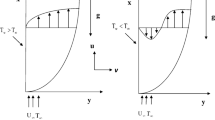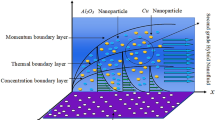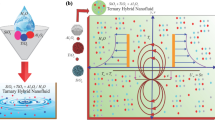Abstract
This study explores the issue of micropolar fluids and heat transfer in a hybrid nanofluid through a moving thin needle with prescribed surface heat flux. Here, SWCNT and MWCNT are referred to as hybrid nanoparticles, and Engine oil and Refrigerant-134A as a working fluid. Similarity transformation is implemented to acquire the similarity equations, and then numerically solved by utilizing the shooting technique bvp4c function. Hybrid nanofluids enhance the heat transfer coefficient when their concentrations and nanoparticle volumes increase. The graphical results are made for different involved parameters such as material parameter, micro-gyration parameter, moving parameter, and index parameter. It is found that the heat transfer and friction drag are improved for hybrid nanofluid than nanofluids. It is further seen that increase in the size of the needle axial and angular velocity and temperature distribution diminishes.







Similar content being viewed by others
References
Agarwal RS, Bhargava R, Balaji AVS (1989) Finite element solution of flow and heat transfer of a micropolar fluid over a stretching sheet. Int J Eng Sci 27(11):1421–1428
Ahmad S, Nadeem S (2020a) Analysis of activation energy and its impact on hybrid nanofluid in the presence of Hall and ion slip currents. Appl Nanosci 10:1–16
Ahmad S, Nadeem S (2020b) Application of CNT-based micropolar hybrid nanofluid flow in the presence of Newtonian heating. Appl Nanosci 10:1–13
Ahmad S, Nadeem S, Muhammad N, Khan MN (2020a) Cattaneo–Christov heat flux model for stagnation point flow of micropolar nanofluid toward a nonlinear stretching surface with slip effects. J Therm Anal Calorim 1–13
Ahmad S, Nadeem S, Ullah N (2020b) Entropy generation and temperature-dependent viscosity in the study of SWCNT–MWCNT hybrid nanofluid. Appl Nanosci 10:1–13
Darjani S, Koplik J, Pauchard V (2017) Extracting the equation of state of lattice gases from random sequential adsorption simulations by means of the Gibbs adsorption isotherm. Phys Rev E 96(5):052803
Darjani S, Koplik J, Banerjee S, Pauchard V (2019) Liquid-hexatic-solid phase transition of a hard-core lattice gas with third neighbor exclusion. J Chem Phys 151(10):104702
Dinarvand S, Pop I (2017) Free-convective flow of copper/water nanofluid about a rotating down-pointing cone using Tiwari-Das nanofluid scheme. Adv Powder Technol 28(3):900–909
Eastman JA, Choi SUS, Li S, Yu W, Thompson LJ (2001) Anomalously increased effective thermal conductivities of ethylene glycol-based nanofluids containing copper nanoparticles. Appl Phys Lett 78(6):718–720
Eringen AC (1972) Theory of thermomicrofluids. J Math Anal Appl 38(2):480–496
Ghasemi H, Aghabarari B, Alizadeh M, Khanlarkhani A, Zahra NA (2020) High efficiency decolorization of wastewater by Fenton catalyst: Magnetic iron-copper hybrid oxides. J Water Process Eng 37:101540
Grosan T, Pop I (2011) Forced convection boundary layer flow past nonisothermal thin needles in nanofluids. J Heat Transfer 133(5):054503
Hassan M, Marin M, Ellahi R, Alamri SZ (2018) Exploration of convective heat transfer and flow characteristics synthesis by Cu–Ag/water hybrid-nanofluids. Heat Transf Res 49(18):1837–1848
Khan U, Ahmad S, Hayyat A, Khan I, Nisar KS, Baleanu D (2020) On the Cattaneo-Christov heat flux model and OHAM analysis for three different types of nanofluids. Appl Sci 10(3):886
Kumar KA, Sugunamma V, Sandeep N (2020) Influence of viscous dissipation on MHD flow of micropolar fluid over a slendering stretching surface with modified heat flux model. J Therm Anal Calorim 139(6):3661–3674
Lee LL (1967) Boundary layer over a thin needle. Phys Fluids 10(4):820–822
Lu D, Ramzan M, Ahmad S, Chung JD, Farooq U (2018) A numerical treatment of MHD radiative flow of Micropolar nanofluid with homogeneous-heterogeneous reactions past a nonlinear stretched surface. Sci Rep 8(1):1–17
Lund LA, Omar Z, Khan I, Seikh AH, Sherif EM, Nisar KS (2020) Stability analysis and multiple solution of Cu–Al2O3/H2O nanofluid contains hybrid nanomaterials over a shrinking surface in the presence of viscous dissipation. J Mater Res Technol 9(1):421–432
Mozaffari S, Li W, Dixit M, Seifert S, Lee B, Kovarik L, Mpourmpakis G, Karim AM (2019) The role of nanoparticle size and ligand coverage in size focusing of colloidal metal nanoparticles. Nanoscale Advances 1(10):4052–4066
Mozaffari S, Li W, Thompson C, Ivanov S, Seifert S, Lee B, Kovarik L, Karim AM (2020) Colloidal nanoparticle size control: experimental and kinetic modeling investigation of the ligand–metal binding role in controlling the nucleation and growth kinetics. Nanoscale 9(36):13772–13785
Nadeem S, Rehman A, Vajravelu K, Lee J, Lee C (2012) Axisymmetric stagnation flow of a micropolar nanofluid in a moving cylinder. Math Probl Eng 2012:18
Ramadevi B, Kumar KA, Sugunamma V, Reddy JVR, Sandeep N (2020) Magnetohydrodynamic mixed convective flow of micropolar fluid past a stretching surface using modified Fourier’s heat flux model. J Therm Anal Calorim 139(2):1379–1393
Sarkar J, Ghosh P, Adil A (2015) A review on hybrid nanofluids: recent research, development and applications. Renew Sust Energ Rev 43:164–177
Sui J, Zhao P, Cheng Z, Doi M (2018) Influence of particulate thermophoresis on convection heat and mass transfer in a slip flow of a viscoelasticity-based micropolar fluid. Int J Heat Mass Transf 119:40–51
Suresh S, Venkitaraj KP, Selvakumar P, Chandrasekar M (2011) "Synthesis of Al2O3–Cu/water hybrid nanofluids using two step method and its thermo physical properties. Colloids Surf A Physicochem Eng Asp 388(1–3):41–48
Suresh S, Venkitaraj KP, Hameed MS, Sarangan J (2014) Turbulent heat transfer and pressure drop characteristics of dilute water based Al2O3–Cu hybrid nanofluids. J Nanosci Nanotechnol 14(3):2563–2572
Waini I, Ishak A, Pop I (2020) Transpiration effects on hybrid nanofluid flow and heat transfer over a stretching/shrinking sheet with uniform shear flow. Alex Eng J 59(1):91–99
Waini I, Ishak A, Pop I (2020) Hybrid nanofluid flow past a permeable moving thin needle. Mathematics 8(4):612
Author information
Authors and Affiliations
Corresponding author
Ethics declarations
Conflict of interest
The authors declare that they have no conflict of interest.
Additional information
Publisher's Note
Springer Nature remains neutral with regard to jurisdictional claims in published maps and institutional affiliations.
Rights and permissions
About this article
Cite this article
Ahmad, S., Nadeem, S. & Khan, M.N. Enhanced transport properties and its theoretical analysis in two-phase hybrid nanofluid. Appl Nanosci 12, 309–316 (2022). https://doi.org/10.1007/s13204-020-01634-1
Received:
Accepted:
Published:
Issue Date:
DOI: https://doi.org/10.1007/s13204-020-01634-1




